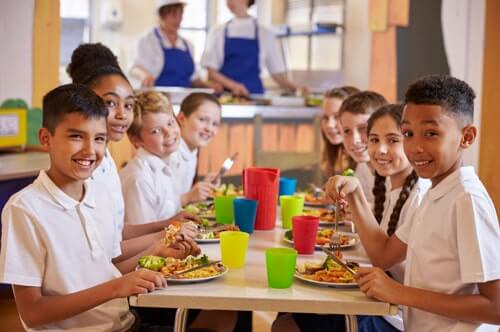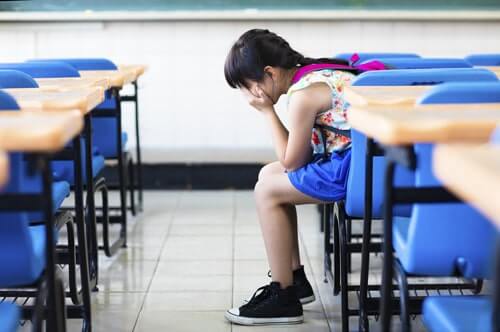Hunger affects 13 million children across America, but throughout the school year, many participate in school food programs that provide them with both breakfast and lunch almost every day of the week.
Programs like the National School Lunch Program (NLSP) and the School Breakfast Program (SBP) were created to provide nutritional assistance to millions of low-income children every year, at a low- or no-cost. Nearly 95% of public and non-profit private schools in America participate in these programs, feeding more than 30 million children daily.
Below we’ll walk through what the NLSP and SBP programs are, how the programs benefit students, who is eligible and how you can apply, how hunger affects students, and what you can do to join the fight against hunger.
Let’s get started!
What is the National School Lunch Program (NSLP)?
The National School Lunch Program was founded in 1964 and is now the nation’s second-largest food and nutrition assistance program, with the Supplemental Nutrition Assistance Program (SNAP) being in the number one slot. The program was established by the National School Lunch Act, which was then signed into law by the Truman administration. This program allows low-income students to have access to school lunches for a reduced price or at no cost, depending on where their households fall on the income scale.

For high-poverty school districts, the additional Community Eligibility Provision allows schools across the country to offer lunch AND breakfast at no charge to all students attending the school - no forms required. Currently, more than 100,000 schools are part of this program.
In 2019, more than 29 million children participated in the National School Lunch Program. That number dropped to 22.6 million in 2020 due to school closings because of the pandemic, but the need was actually higher than ever. COVID-19 exacerbated food insecurity in the United States, with 18% of households with children reporting food insecurity in 2020 compared to 15% of households in 2019.
Through the NSLP program, schools are also able to participate in an after-school snack program. For schools to be eligible for this program, the school must already participate in the National School Lunch Program and operate an afterschool program. In turn, snacks are able to be provided by the schools to qualifying students.
To be eligible for this program after-school snacks must contain at least two different components of the following four to meet federal requirements:
- a serving of fluid milk
- a serving of meat or meat alternate
- a serving of vegetables or fruits or full-strength vegetable or fruit juice
- a serving of whole grain or enriched bread or cereal
What is the School Breakfast Program?
The School Breakfast Program was started in 1966 as a pilot program and was made a permanent program in 1975. Similar to the National School Lunch Program, more than 100,000 schools participate in this program.
While nearly 30 million students participate in the National School Lunch Program, only about 15 million students participate in the School Breakfast Program. This could be because many schools only offer the breakfast program before school begins in the morning, and the student's transportation doesn’t make it to the school in time.
Some schools offer the School Breakfast Program in the classrooms, allowing students to eat breakfast as part of their morning routine. About 42% of students who don’t participate in the School Breakfast Program said they would if the breakfast was offered in the program.

How To Qualify for School Food Programs
To qualify, a parent or guardian must complete a form provided by the school to evaluate if you meet the income eligibility requirements for the program, which varies based on your location. If your household has already been approved for the SNAP, Temporary Assistance for Needy Families (TANF), and/or Women, Infant, and Children (WIC) programs, children are automatically eligible for free school meals.
It’s important to note that while these school food programs serve around 30 million children each school year, not all of these children are considered food insecure. Children that live in households with income below 185% of the poverty line are considered eligible for reduced or no-cost lunches. While these 30 million children may be considered low-income, only about 13 million are categorized as food insecure.
What is Food Insecurity?
Food insecurity is defined as “a lack of consistent access to enough food for an active, healthy life.”
According to the U.S. Department of Agriculture (USDA), there are 4 tiers to food security. Being classified as “food secure” consists of the top 2 tiers - high food security and marginal food security. Being considered “food insecure” consists of the bottom 2 tiers - low food security and very low food security.

The defining characteristic of low food security is that “food intake of household members is reduced and their normal eating patterns are disrupted because the household lacks money and other resources for food.”
The USDA determines the United States food insecurity statistics through a national survey that is an addition to the monthly Current Population Survey (CPS). The CPS is a “nationally representative survey conducted by the Bureau of the Census for the Bureau of Labor Statistics. The CPS provides data for the nation's monthly unemployment statistics, and annual income and poverty statistics.” The survey contains questions for households to complete that cover a wide range of severity in relation to their food security that year. About 40,000 households respond to the survey, which are the households that represent civilian households.
Food insecurity doesn’t have an income qualification, although it is closely associated with poverty. However, not all people living below the poverty line are considered food insecure and people who live above the poverty line are still susceptible to food insecurity.
How Hunger Affects Children During School
We’ve all experienced the unpleasant consequences of going too long without food; headaches, dizziness, lack of concentration, etc. Now, imagine how much a lack of food can affect a student.
Students who face hunger daily are more likely to score lower on standardized tests, repeat a grade, get sick more often, and be suspended from school. 46% of students from low-income households say hunger impacts their performance in school and 3 out of 4 teachers recognize students who regularly come to school hungry.
Yet, with these programs in place, 77% of students say school meals help them feel physically better by reducing stomach and headaches. 74% of students say they’re able to concentrate better due to school meals, and 71% say their grades are better with access to school meals.
What Can We Do?
Unfortunately, food insecurity in America is still on the rise. Move For Hunger is working hard with partner organizations to fight childhood hunger, but we need all the help we can get! If you want to join the fight, visit our Take Action page today!

Hosting a food drive or fundraiser to raise donations for food banks and pantries is also always a great option to join the fight against hunger! This helps make sure local food insecure communities have access to meals and food banks have well-stocked shelves.
Additionally, it’s important to educate yourself and raise awareness on the hunger crisis in America. To learn more about childhood hunger in the United States, read our Summer Hunger blog. You can also learn more about how hunger disproportionately affects marginalized communities, like women, the LGBTQ+ community, and minorities.
We also need to strengthen our federal nutrition programs. The National School Lunch Program, the School Breakfast Program, the Summer Food Service Program, WIC, and SNAP safeguard our children from the dangers of hunger and poverty. We all need to advocate for and support these life-saving programs.
If you’d like to make an impact immediately, consider donating today! A donation as small as $25 feeds 63 people.
